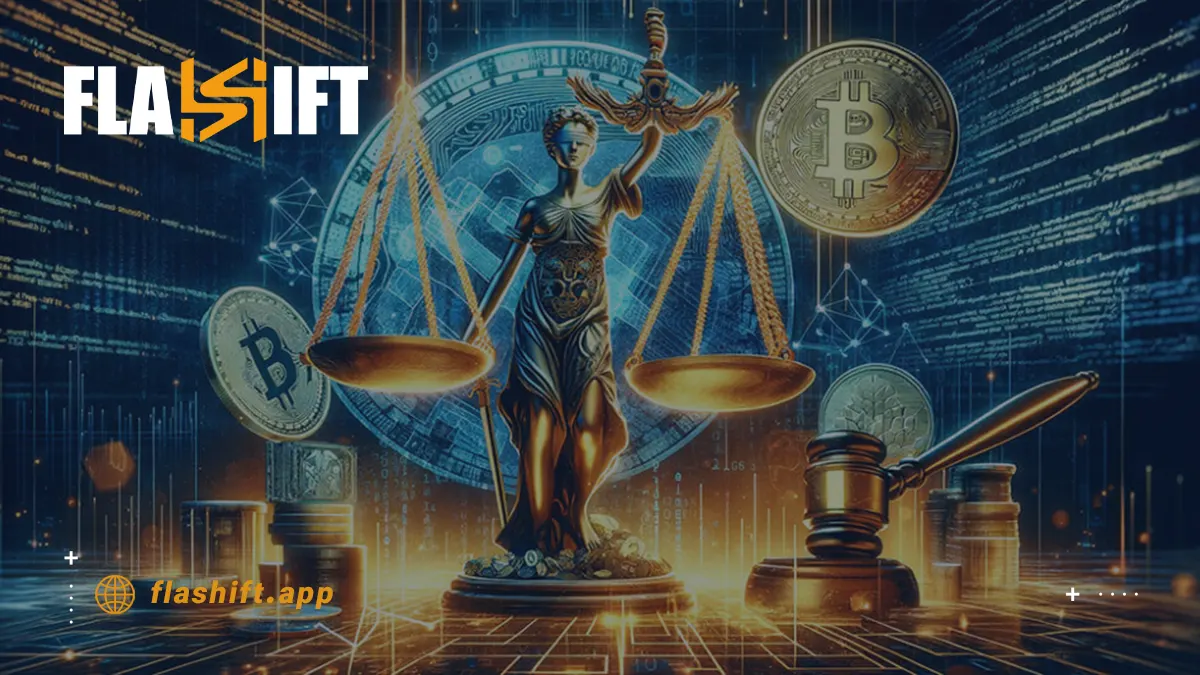Crypto Regulation | Cryptocurrency markets are known to be very volatile and fast-changing, depending on changing regulations worldwide. To keep up with the fast-rising digital asset space, different governments, and regulatory bodies have been working to establish a framework for this space. Changes in regulation-from AML laws to cryptocurrency tax policies, even securities legislation-continue to impact cryptocurrency markets profoundly.
Consequently, this paper discusses some of the implications for investors’ behavior, market liquidity, exchange operation, and general development of the blockchain ecosystem. Keeping tabs on these regulatory changes is crucial to understanding how digital currencies will shape up in the future.
To exchange cryptocurrency at the best rate, visit the Flashift website, create a registration-free transaction, and enjoy a secure and speedy experience.
Overview of Cryptocurrency Regulations Worldwide
In general, cryptocurrency regulation globally takes very diverse dimensions, with each government taking some unique approaches to this changing asset class quickly. For example, some countries, such as the United States, base their work on keeping cryptocurrencies within the frames of existing legal regimes. In the United States, regulators take the view that cryptocurrencies are either securities or commodities; thus, under the auspices of central watchdogs-the Securities and Exchange Commission and the Commodity Futures Trading Commission-the exchanges and token issuers face a slew of strict oversight and compliance requirements. On the other hand, revenue authorities like the Internal Revenue Service have implemented regulations on how crypto should be declared and treated as taxable in terms of its properties.
On the other hand, countries like Japan and Singapore open their arms to more crypto-friendly regulations. Japan, through the FSA, was one of the first major world economies to officially recognize cryptocurrencies when it classified Bitcoin as legal tender in 2017. This, therefore, has made Japan a hotbed of crypto innovation and investment owing to its friendly regulatory regime. Similarly, Singapore has issued detailed guidelines through the Monetary Authority of Singapore under the Payment Service Act on regulating digital payment tokens, allowing innovation to flourish while protecting consumers from fraud and possible financial crimes.
Cryptocurrency regulation in Europe is becoming more harmonized with the pending Markets in Crypto-Assets Regulation, which will come into force under the European Union. MiCA focuses on establishing a single crypto regulation framework across EU states, including investor protection, oversight of stablecoins, and licensing amongst crypto service providers. Meanwhile, other European countries, such as Germany and Switzerland, have been in the lead regarding identifying clear legal boundaries for virtual currencies. Switzerland has been specifically highlighted as a blockchain-friendly country, with regulations that have seduced several crypto enterprises.
On the contrary, some countries still tend to hold a highly restrictive or even hostile attitude toward cryptocurrencies. For example, China has taken extensive measures to ban trading and mining activities with cryptocurrencies due to concerns over the financial stability and environmental impact of cryptocurrencies. India has continued to seesaw between contemplating an outright ban and developing a regulatory framework for digital assets. Indeed, the contrast of these approaches globally underlines the complexity of regulating cryptocurrencies and the many ways different nations are navigating how to foster innovation while mitigating risks in this fast-moving market.
Recent Regulatory Changes and Their Effects
There have been significant shifts in cryptocurrency regulation over the past few years as various governments seek to handle both the opportunities and risks of digital assets. Regulators in the United States have been increasing their scrutiny more and more, with the Securities and Exchange Commission accelerating enforcement against unregistered token offerings and cryptocurrency exchanges. An excellent example is the Far-gone debate on whether some digital currencies, such as Ripple XRP, are securities. This has broad ramifications on the more significant market. Regulatory steps like this have brought about uncertainty, which also influences market sentiment and forces some crypto businesses to think about their migration to friendlier jurisdictions.
Meanwhile, the currently discussed European Union Markets in Crypto-Assets regulation is a sea-change moment that would provide further clarity for the crypto ecosystem in Europe. Once the law is enacted, MiCA will establish a consistent regulatory framework throughout EU members, from ICOs to stablecoins to crypto service providers. It will also protect investors and prevent market abuse while advancing innovation in the digital asset area. Anticipation of MiCA has already shown some ripple effects: Many European crypto firms have been adjusting their compliance strategy to factor in the upcoming rules, which could spur more institutional investment in the space.

Several countries in the region have rolled out regulatory changes directly to hit the crypto market with a sledgehammer. New regulations introduced in 2021, for example, require that all crypto exchanges in South Korea register themselves with financial authorities, with strict anti-money laundering standards in place. In this way, many of the minor exchanges could not meet such demands and had to shut down, which furthered the consolidation of market power in a few large hands. Similarly, in 2021, China cracked down on cryptocurrency mining and trading, creating behemoth-like effects where it temporarily tamped down Bitcoin’s hash rate, forcing any form of mining operations to move elsewhere to countries such as the U.S. and Kazakhstan.
These regulation changes have reshaped not only the geography of the industry but also the focus of market participants. Compliance has risen to the fore, especially among institutional investors who look for regulatory certainty before entering the market. Yet, as governments continue to evolve their approaches to cryptocurrency regulation, the central challenge remains striking the right balance between fostering innovation and ensuring oversight. Increased regulation is, for many crypto community members, a double-edged sword in that it offers legitimacy and wider adoption while risking ending the decentralized ethos underlining the cryptocurrency movement.
How Regulations Impact Crypto Prices
Cryptocurrency prices are susceptible to regulatory news, as even the tiniest changes in government policy can send prices into steep volatility. The spikes following such an announcement-often sharp price fluctuations-occur as market participants react both to perceived risks and opportunities from new laws or enforcement actions. When the U.S. Indeed, in 2017, the Securities and Exchange Commission announced the crackdown on Initial Coin Offerings, several tokens’ prices nosedived as investors started getting scared of possible legal implications.
Similarly, in recent times, regulatory uncertainty over whether some cryptocurrencies constitute securities has caused price volatility for the affected assets themselves, as is occurring now in the ongoing Ripple case involving XRP.
On the contrary, positive regulatory changes may also lead to price increases due to increased investor confidence and market legitimization. For example, the European Union’s introduction of the Markets in Crypto-Assets, commonly known as MiCA, regulation was viewed as a significant step toward establishing an atmosphere of safety and predictability for crypto investments. Among other benefits brought about by such developments, prices of some cryptocurrencies-certainly large-cap assets like Bitcoin and Ethereum-have stretched through periods because of such eventualities at the back of anticipation for greater institutional involvement and wider adoption due to more precise rules.
Regulation can also have a collateral effect on crypto prices in terms of market liquidity and how exchanges operate. Strict regulations, such as the AML/KYC regulations enforced in many jurisdictions, reduce access to crypto markets, particularly to smaller retail investors. In countries where controls on the exchanges have been tight enough to force their closure, liquidity dries up, and prices become increasingly volatile. This was the case in South Korea, where updated AML legislation forced smaller exchanges out of business in 2021, adding to local price volatility.
Aside from legislation, regulatory bans and restrictions have significantly disrupted crypto prices several times. Starting with the 2021 ban by China on cryptocurrency mining and trading, Bitcoin’s price drastically fell since miners were forced to shut down or relocate their activities. Miners shutting down operations reduced the network’s hash rate and plunged investors’ confidence. Shocks instituted by regulators, especially in key markets like China or the United States, often result in short-term market sell-offs as traders react to sudden changes in the operational landscape. More explicit regulations would also mean excellent stability because uncertainty will be lower, giving way to more sustainable price trends as market maturity sets in.
Navigating Compliance in Different Jurisdictions
As the institutional and retail cryptocurrency market grows, one of the most significant pain points for companies operating in the space is making sense of how to be compliant across a multi-jurisdictional landscape. That being said, countries have taken their own set of regulations around their digital assets, and hence, crypto companies need to operate accordingly, within the ambit of these varied legal requirements. From strict AML measures to the requirements of licensing and securities laws, knowing one’s way around them means penalties avoided, market access kept open, and the building of trust from users and investors alike.
United States: Regulatory Patchwork
Cryptocurrency regulation in the US is a many-headed beast, with different market areas falling under the remit of other agencies. The SEC has been at the center of defining when a digital asset is a security. Hence, crypto companies must register their offerings and comply with regulations. In return, ICOs have come under greater scrutiny, as have DeFi projects. Meanwhile, the CFTC regulates digital assets like Bitcoin as commodities. This means added complexity to the compliance required for any business that offers crypto derivatives or futures trading.
In addition, crypto companies in the United States are supposed to work in essential consistency with federal and state regulations, which differ vastly. Individual states, such as New York, have taken matters into their own hands and established strict licensing regimes, like BitLicense, that require virtual currency businesses to have an extremely high standard regarding consumer protection, financial stability, and anti-fraud measures.
Consequently, many crypto firms avoid operating in jurisdictions with onerous requirements, while others spend a lot on legal and compliance resources to operate confidently within any given regulatory patchwork.

Europe: Towards Harmonized Regulation
Europe is far more homogeneous in its vision for cryptocurrency regulation, particularly under the future Markets in Crypto-Assets regulation. It seeks to establish an everyday regime across the EU member states and, for once, clean up the mess in the existing regulatory landscape: token issuances, stablecoins, and crypto service providers activities all touched upon. For business operations traversing Europe, MiCA will free them from the headache of having to deal with a morass of diversified national laws within the block.
Currently, many countries have their frameworks running in the region. For instance, Germany requires all custodians of cryptocurrency to obtain licenses from BaFin – the Federal Financial Supervisory Authority; France also brought a regulatory framework under the PACTE law early this year, which will enable the firms to get themselves registered with the country’s Financial Markets Authority, the AMF. Although Switzerland is not part of the EU, it has secured first place regulating blockchain. FINMA has given crypto companies a green light through clear guidelines and a business-friendly environment.
Asia: A Delicate Balance Between Innovation and Control
Asia’s vast and diverse regulatory landscape hosts jurisdictions as liberal as Singapore and Japan and as conservative as China and India regarding cryptocurrency regulation. Singapore has developed, through its MAS, a sound but flexible regime under the Payment Services Act that supervises digital payment token services for consumer protection while enabling innovation. That has made Singapore a center of blockchain startups and crypto exchanges in Asia.
Japan is also crypto-friendly. Since 2017, It has legally recognized Bitcoin as a form of legal tender by instituting a licensing regime for crypto exchanges under the Financial Services Agency regulator. Such regulations have legalized the Japanese crypto market and attracted major companies worldwide to set up operations.
Meanwhile, China has implemented broad-ranging bans on trading and mining cryptocurrencies, forcing most crypto businesses out of the country. Even India has not been immune to regulatory uncertainty: once its government proposed a ban on all things cryptocurrency, it is now reportedly considering a legal framework to regulate the market. This makes it imperative for businesses operating in Asia to remain vigilant, adapting at speed and with agility through changing regulatory landscapes since the region remains in a state of evolution regarding the regulation of cryptocurrencies.
Challenges of Compliance: How to Adapt
In other words, ensuring all compliance aspects are met in multi-jurisdictional operations is complex and highly resource-intensive for crypto firms. Firms often hire legal expertise, compliance teams, and technology solutions, among other solutions, to manage multi-regulatory requirements across several regions. This includes critically robust know-your-customer requirements and anti-money laundering controls to conform to the requirements imposed by most jurisdictions, including countries such as the United States, the European Union, and Singapore.
DeFi projects face even more serious difficulties following compliance due to their structure, which, in most cases, does not provide for a central entity to oversee the observance of regulations. That is why DeFi projects increasingly look to partner with RegTech companies to automate compliance processes and stay transparent with regulators.
In summary, cryptocurrency compliance in one or more jurisdictions requires an understanding of each region’s regulatory landscape and adaptability to new legislation and enforcement laws. The ever-evolving nature of regulators around the globe as they crystallize their positions on digital assets will strengthen businesses that prioritize compliance while augmenting relationships with regulators.
The Role of Regulatory Bodies in Crypto
The regulatory bodies are playing an important role in the development and functionality of cryptocurrency markets around the world. Considering the further development of digital asset use, their responsibility involves ensuring market transparency and consumer protection and keeping the risks associated with fraudulent deals, money laundering, and market manipulation at bay.
Such regulatory bodies usually play a crucial role in drafting and implementing rules that will create a safer and more sustainable environment for all cryptocurrency participants, whether they are investors, exchanges, or other service providers. Importantly, its decisions set the course of the crypto industry in a necessary balance between innovation and financial stability.
Protecting Investors and Ensuring Market Integrity
Aside from investor protection, regulatory bodies in the cryptocurrency space have played significant roles in protecting them from fraud, scams, and unfair market practices. Due to their decentralized nature and high level of anonymity, cryptocurrencies have been historically linked to schemes such as Ponzi, unregistered initial coin offerings, and other fraudulent activities.
Examples of regulatory bodies include those in the U.S. The Securities and Exchange Commission plays a vital role in enforcing laws on securities to try to contain such practices. For example, the SEC has taken decisive actions against several ICOs and crypto projects that fell foul of securities law, which have proved vital in setting more explicit boundaries on what, in fact, constitutes a valid offering.
It also ensures that cryptocurrency exchanges and service providers are sufficiently transparent and fair. This includes imposing rules on market manipulation cases such as wash trading and pump-and-dump schemes. In this regard, regulators reinforce market integrity, which is essential for investor confidence and the long-term growth of the crypto market.
Combating Financial Crimes and Enhancing Security
It is a critical issue in cryptocurrency regulation in fighting financial crimes, money laundering, terrorist financing, and tax evasion. Several cryptocurrencies have come into use due to their pseudonymous nature for criminal activities. Thus, regulatory bodies are working to eliminate these risks by imposing strict anti-money laundering requirements and know-your-customer on crypto exchanges and service providers, the Financial Action Task Force, and national financial authorities.
For example, the Fifth Anti-Money Laundering Directive, 5AMLD, issued by the European Union, extended AML requirements to crypto businesses, meaning such companies must implement customer due diligence and report suspicious activities.
Likewise, in the United States, FinCEN imposes AML requirements on crypto businesses to ensure that such companies are not used to facilitate ill-gotten activities. They offer the opportunity for regulatory bodies to set standards that will help prevent the use of cryptocurrencies for criminal purposes and, by extension, operate within the rule of law.
Promoting Innovation While Maintaining Stability
They must also do this in a balanced way to favor innovation and not compromise financial stability. This is because blockchain technology and digital assets have a strong potential to disrupt several industries, not limited to finances alone. The governments of countries like Singapore and Switzerland and their regulators have been very proactive and innovation-friendly. They have developed friendly regulatory frameworks that welcome blockchain startups while at the same time ensuring consumer protection.
For instance, the Monetary Authority of Singapore proposed the Payment Services Act, a law regulating digital payment token services. By setting clear boundaries within which businesses can operate, MAS creates an environment enabling innovation. Hence, these crypto companies get to grow under apparent regulation.
However, when it becomes overly stringent, it kills innovation, and companies and developers will shift to jurisdictions that are friendly to their cause. Crypto firms have left countries with strict policies against the operation of cryptocurrencies, such as China.
Global Coordination and Standardization
The global nature of these cryptocurrency markets means regulators must coordinate across borders. Given the ease with which cryptocurrencies can be traded and, even more importantly, transferred across jurisdictions, the enforcement situation becomes complex and indicates lapses in regulation. International bodies like the Financial Action Task Force play a very relevant role in establishing global standards for regulating cryptocurrencies, ensuring consistent rules among countries to avert regulatory arbitrage.
The FATF recommendations on crypto regulation included the so-called “travel rule,” in which recommended exchanges and service providers share customer information when transactions surpass a threshold. This move is intended to fight money laundering and terrorism financing.
Other countries, such as the European Union and Japan, also work on harmonizing regulations and laws related to virtual currencies through initiatives like MiCA. Later, this framework will provide a common framework among EU member states regarding crypto regulation. This crucial international cooperation will ensure that the fast-evolving cryptocurrency market is subjected to the most authoritarian oversight globally.
It follows, therefore, that regulatory bodies are critical determinants of the future of cryptocurrency markets. Given the protection of investors by preventing financial crimes, fostering innovation, and orchestrating global efforts, these entities will help create a much safer, transparent, and stable climate for the digital asset industry to blossom. Their continuous work will be crucial as development and mainstream adoption continue in cryptocurrency.
Read More: Top 10 Cryptocurrency Trading Strategies for Beginners in 2024
Future Outlook on Crypto Regulation
In the future, greater clarity will arise in cryptocurrency regulation with strong legal frameworks. Sorting out various gaps and inconsistencies will be conducted from jurisdiction to jurisdiction. Regulators worldwide are trying to clearly define the rules related to the classification, trading, and taxation of digital assets as they become more integrated into mainstream financial systems.
For example, the MiCA regulation of the European Union will fully establish a regime for digital assets and clarify essential topics, such as how to handle stablecoins and crypto service providers. Efforts to develop a more coherent regulatory framework are underway in the United States, especially in light of high-profile enforcement actions against exchanges and token issuers. This will also bring greater legitimacy and stability to the crypto market, with a wider institutional adoption likely.
Another leading trend in the future of cryptocurrency regulation is global standardization. Since it is both decentralized and cross-border, heterogeneous regulations could conflict, presenting challenges in enforcement and risk mitigation. International bodies like the Financial Action Task Force have already started setting global standards for crypto regulation, including guidelines such as the requirement for AML/KYC.
This, in turn, implies that state collaboration in the future will be necessary to set up one legal environment that will minimize options for regulatory arbitrage and allow for the same consistent oversight of digital assets across borders.
The rise of emerging technologies, including DeFi and CBDCs, will also determine the future of cryptocurrency regulation. As more DeFi platforms gain widespread attention, regulators must figure out how to accommodate these decentralized protocols within existing financial frameworks without killing innovation. For example, governments can enact regulations forcing DeFi platforms to work by AML and KYC standards, just like centralized exchanges.
Another impact will be that CBDCs are part of a shift in the regulatory landscape, one where a rival to decentralized cryptocurrencies will be brought into the world and backed by the state. Policymakers will need to consider how they regulate private digital assets in comparison. These will be crucial to setting the future environment where cryptocurrency regulation and the broader financial ecosystem take shape.
A Growing Area of Focus
As the crypto landscape matures, Decentralized Finance (DeFi) has emerged as one of its most disruptive segments, challenging traditional financial structures with innovative services like lending, borrowing, staking, and yield farming. Unlike centralized exchanges, DeFi protocols operate without middlemen, relying on blockchain-based smart contracts to facilitate transactions. While the freedom and accessibility of DeFi services have fueled their explosive growth, they have simultaneously raised critical concerns about accountability, fraud prevention, and regulatory compliance.
FAQ
- Which are crypto-friendly?
Japan, Singapore, and Switzerland have been said to be crypto-friendly because their governments have established a clear regulatory framework that permits innovation while protecting investors.
- Which countries are more restrictive regarding crypto?
China and India were more restrictive. China recently banned crypto trading and mining, while India has flipped between preparing a possible ban and developing a regulatory framework.
- Which recent regulatory changes have affected the crypto industry?
The SEC’s enforcement action against token offerings has muddled things in the U.S. At the same time, the prospective MiCA regulation in the EU promises clarity through a rulebook for crypto assets in Europe.
- How are crypto markets doing after these changes?
Regulatory uncertainty is among the reasons for the price swing, as tokens like Ripple XRP attest. On the other hand, more transparent regulations, such as MiCA, have been embraced by investors and instilled confidence in the market.
- How do crypto prices change in response to regulatory announcements?
Volatility has often followed regulatory announcements: good news builds confidence in investors and pushes prices higher, while crackdowns or bans send prices downward.
- Can good regulation move prices higher?
Of course, favorable regulations like the MiCA from the EU and crypto ETF discussions in the U.S. have repeatedly sent prices higher by legitimizing the market and opening the doors to institutional investors.
- Why is it so challenging to regulate cryptocurrencies?
Cryptocurrency crosses borders, and each jurisdiction has its own set of rules. Navigating this patchwork of regulation requires a deep understanding of local laws.
- Which countries are making a lot of strict compliance demands?
The U.S., and most specifically, New York, has its BitLicense. Europe will also apply powerful compliance features in the new MiCA regulations.
- What role are regulatory bodies playing in cryptocurrency?
The regulatory bodies draft and implement investor protection guidelines and fraud prevention and maintain crypto market integrity. They also attempt to combat financial crimes, including money laundering.
- Which regulatory bodies are concerned with crypto regulations?
Central bodies include the US SEC, CFTC, and FinCEN, as well as international organizations such as the Financial Action Task Force (FATF) and regional authorities, including the EU.
- How do regulators balance innovation and control?
Regulators in some jurisdictions, such as those in Singapore and Switzerland, have outlined clear frameworks that strike a balance between encouraging innovation and offering consumer protection while maintaining financial stability.
- What could cryptocurrency regulation look like in the future?
In the future, clearer and more comprehensive regulatory frameworks will likely be introduced to protect investors and foster innovation. This will likely happen in regions like the EU and the U.S.
- Will there be global standards for crypto regulation?
However, there is also a drive toward global regulatory standardization, particularly in organizations such as the FATF, to ensure a level playing field and prevent regulatory arbitrage across borders.






